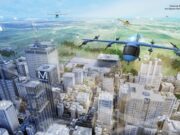Most pilots preparing to land their airplanes as part of a small study were unable to see small drones approaching their airspace, and virtually all of the pilots were unable to detect stationary drones, researchers said in a report released today.
In 28 of 40 cases, the pilots did not detect “a common type of quadcopter” — a DJI Phantom IV — as it neared their approach path, researchers from Oklahoma State University and Embry-Riddle Aeronautical University said. Their findings were published in the International Journal of Aviation, Aeronautics and Aerospace and in a summary from Embry-Riddle.
When the drone was motionless, it was spotted in only three of 22 cases, the report said.
The distances from which drones were detected ranged from 213 to 2,324 ft (65 to 709 m).
Ryan J. Wallace, an assistant professor of aeronautical science at Embry-Riddle, said the findings are examples of an increasing threat to aviation safety.
“Dangerous close encounters between aircraft and drones are becoming an increasingly common problem,” Wallace said. “Statistics on pilot sightings of drones continue to increase year over year, and what is being reported by pilots is probably just the tip of the iceberg. The vast majority of the time, unmanned aircraft are not being seen by pilots.”
Matt Vance, an assistant professor of aviation and space at Oklahoma State, said that, in a best-case scenario, if a pilot saw the drone from the study’s maximum detection range of 2,342 ft, he or she would have about 21 seconds to avoid a collision.
“That might be enough time if the drone was hovering in one spot, but not nearly enough it it’s in flight, headed for the aircraft,” Vance said.
The pilots who participated in the study were selected from a college flight-training program, and their flights were conducted in a Cessna 172S. The Cessna pilots were told that they might or might not encounter a drone during their flights.



